The build-up to a marathon is a big commitment. Most people train for 12-15 weeks (3 months). Generally, training plans suggest you should be running 5 times each week with 2 rest days spaced between.
Top running coach Martin Yelling, who provides a variety of training plans for the Virgin Money London Marathon offers this advice:
The key is to make the plan personal to you. If you’re feeling tired, adapt the plan or go for an ‘easy’ run instead of trying to force yourself to fi t in the workout and risk fatigue, injury or illness.
Most people do their longest run at the weekend, and will want to build the distance up gradually over the 3 months to 20-22 miles including sections at marathon target pace.
The rest of the week will be made up of a combination of tempo, threshold (or HIIT) and easy recovery runs. Typically, you will want to do 2 harder tempo / threshold / HIT sessions and 1 or 2 easy HR zone 1 pace runs of 30 – 50 mins.
Why use HRV for marathon training?
Monitoring heart rate variability (HRV) can help improve the effectiveness of your training and reduce the chances of illness and injury. Specifically, HRV can help:
- Decide which days to do the tempo / threshold / HIT sessions and which days to go easy
- Alert you when your training and recovery are not well balanced
- Early identification of when you may be becoming sick
- Track improvements in your aerobic fitness
- Plan & execute your taper towards the event
1. Decide which days to do the tempo / threshold / HIT sessions and which days to go easy
The easiest way to do this is using the traffic light scheme in the ithlete mobile app:
- Green: Tempo / threshold / HIT
- Amber: Easy run
- Red: Rest
A more sophisticated way is to use the ithlete Pro Training Guide:
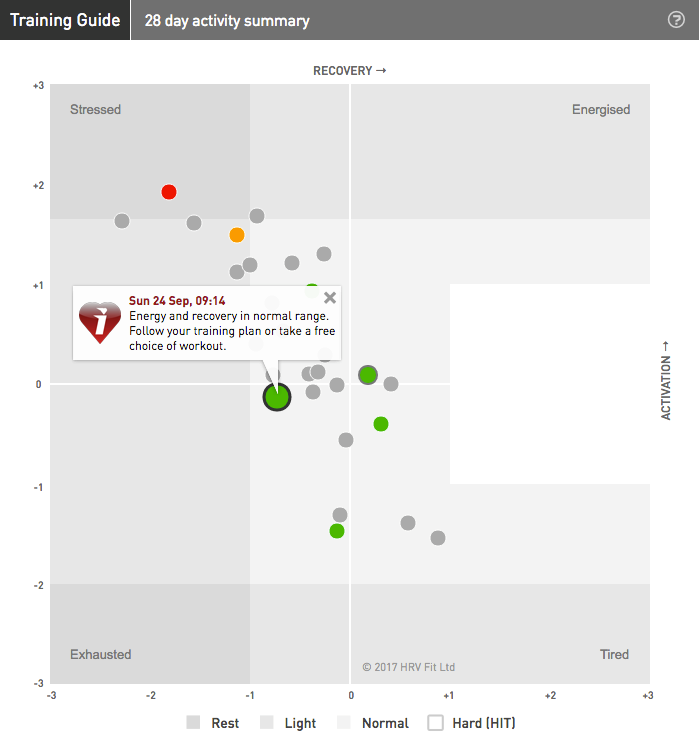
This day’s reading is in the green zone, but is a little to the left of centre, showing a small recovery deficit, so you would probably want to choose a tempo session rather than threshold or HIT. This chart also shows a recent amber, where there was a definite recovery deficit and a red, clearly showing a stress response that requires rest.
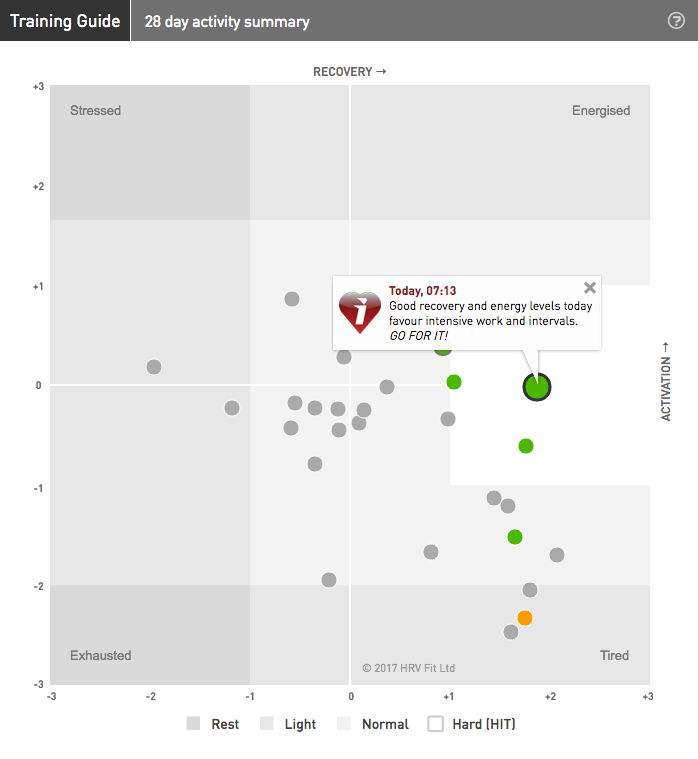
This reading on the other hand shows a day when recovery is significantly better than normal and would be a good day for threshold or HIT work. Recent research has shown better adaptation and results when HIT sessions are performed on good HRV days.
2. Alert you when your training and recovery are not well balanced
Training is all about overload and recovery, when the body is stimulated to adapt and get stronger. Hard training is fine, so long as you allow time for, and facilitate recovery. The problems start when either too many hard training days are put in too short a space of time, or other sources of stress (work, relationships, etc.) create a total load that is too high for your body to cope with.
The ithlete Weekly and Monthly change indicators are key to identifying when the load has become too high, here is a dramatic illustration of what happens to HRV in this situation: Research Summary: A Successful vs An Overtrained Triathlete
Higher levels of HRV enable you to cope with higher training stress loads. Endurance coach Alan Couzens is a fan of using HRV in training, and says:
‘Our ability to continue to respond strongly to training over a long period of time is tied to the strength of our parasympathetic nervous system.’
3. Alert you when you may be becoming sick
HRV is associated with activation of the immune system, and studies have shown that sudden unexpected changes in HRV can precede the onset of common colds, flu and other illnesses. An unexplained red HRV reading is always a cause for concern.
The section of Timeline chart from ithlete Pro below shows how ithlete gave a red warning the day before cold symptoms really developed. With an early warning, you can prepare better by taking time off training, getting an early night and taking vitamin C, zinc and selenium supplements to reduce time out to a minimum. Similarly in days after heavy training when you have an amber or red reading, your immune system is weaker and it’s a good idea to avoid areas where germs may be present.
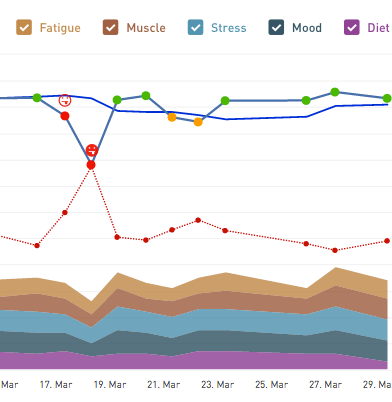
4. Track improvements in your aerobic fitness
If your training is progressing well, and you are balancing training with sufficient recovery, you will see your HRV trend upwards, and your resting HR trend downwards as shown in the example below.
Rises in HRV have also been shown to predict later improvements in aerobic fitness, as measured by VO2 max.
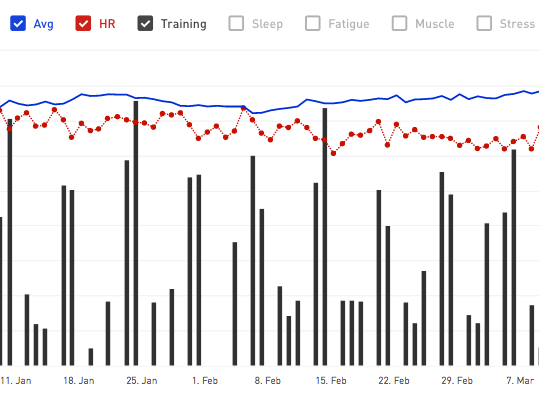
5. Plan and execute your taper towards the event
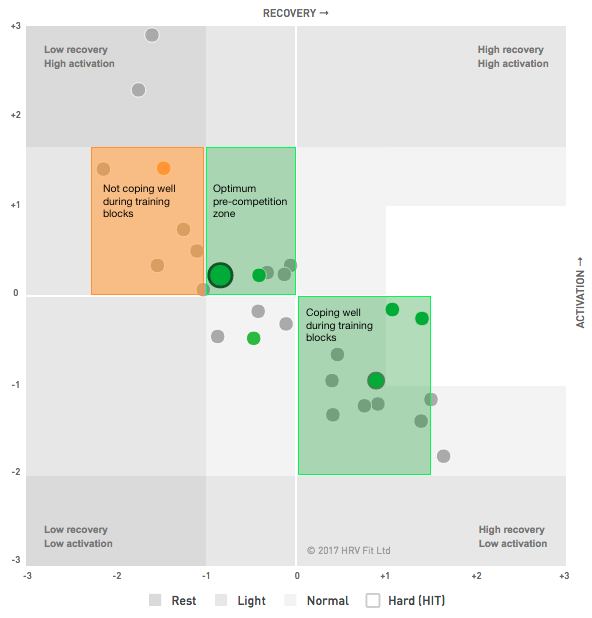 Most people start to reduce the volume of their training by 40-50% but will want to retain at least one of the faster sessions of the week to keep their bodies awake and ready for action. You will likely see your HRV rise as the training load is reduced, and the day to day variation (CV) should decrease too. Don’t worry if your HRV starts to go down a little though, since as this chart from ithlete Pro shows, the optimum pre-competition zone is with your HRV slightly lower than during the bulk of your training (but not amber), and your activation slightly higher than normal.
Most people start to reduce the volume of their training by 40-50% but will want to retain at least one of the faster sessions of the week to keep their bodies awake and ready for action. You will likely see your HRV rise as the training load is reduced, and the day to day variation (CV) should decrease too. Don’t worry if your HRV starts to go down a little though, since as this chart from ithlete Pro shows, the optimum pre-competition zone is with your HRV slightly lower than during the bulk of your training (but not amber), and your activation slightly higher than normal.
On the day of the race, we would recommend you don’t take a reading. Pre-event nerves and unfamiliar surroundings combined with an early start are likely to reduce your HRV, and you don’t want to be put off by an amber or even red HRV warning. Don’t worry though – these will not affect your performance on the big day!
